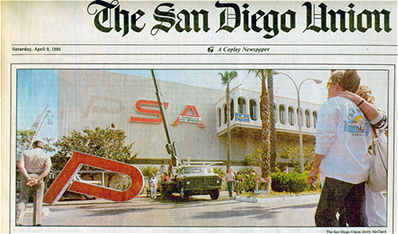
The final chapter in Pacific Southwest Airlines' colorful history was written early today when San Diego's homegrown carrier merged with USAir.
The airline that built its reputation on low fares, frequent service and fun was transformed in an "overnight metamorphosis" into the West Coast arm of USAir.
About three dozen employees gathered at Lindbergh Field's gate 18 to watch the airline's last plane leave San Diego at 10:35 p.m. "I'll bet if you look in this crowd, you'll see some tears," said Ken Dodd, a passenger service agent who wore a tuxedo for the occasion.
Passenger service agent Wayne Stokes ran up and kissed the smile on the plane as the door of the Las Vegas-bound jet was being closed.
"We had to be here for the last dispatch'" Stokes said.
Maintenance crews had stripped PSA logos from the planes and replaced them with USAir emblems as they landed last night at the airline's 28 airport terminals. More than 500 terminal and highway signs were removed during the nine-hour operation that began as darkness fell.
Hundreds of employees flocked to the airline's Lindbergh Field headquarters on the red-letter day that started with the removal of the corporate sign.
"It's almost like a grieving process," said Kathy Angius, who joined PSA as a flight attendant 19 years ago. "You have to come out and say goodbye."
As the sign came down, flight attendant Laura LeBaron admitted to being "choked up" over the demise of the airline. "It's the end of an era for us. We're saying goodbye to a family that grew up together."
A carnival atmosphere pervaded the crowd as it waited for the beginning of the end. T-shirts emblazoned "PSA farewell" sold like hotcakes at a makeshift souvenir stand near the entrance of the headquarters building While a local radio station broadcast live from a nearby tent.
But as the first letter in PSA's trademark logo was removed from the building, the smiles vanished from the faces in the crowd.
"Twenty years of our life are gone," said pilot Dave Sheridan. "It's like they're burning down the schoolhouse. You see a lot of sadness and emotion today because we know things aren't going to remain the same."
USAir acquired PSA last May for about $400 million, but operated the two airlines independently until today. PSA, which had vigorously maintained it would remain independent, agreed to be acquired in December 1986 after airline officials came to the realization "that we were either going to have to buy somebody or be bought."
The most obvious change resulting from the merger is the removal of the now-famous painted smile from the nose of PSA's jets.
Maintenance worker Dan Wicklund said his co-workers have been jokingly "giving me dirty looks and harassing me" for the past six months as he wiped the smile off the jets.
"I think taking the smiles off the plane is indicative of how it's going to be with USAir," said a flight attendant who asked that her name not be used.
The smile that PSA adopted as a advertising gimmick in the late 1960s became synonymous with the carrier's operating style.
"There were no formalities," said J. Floyd Andrews, a co-founder of the airline that began commercial service in 1949. "We wanted to offer a good service with lots of fun and dependability."
The airline set the trend for California air travel, forcing competitors to respond to cut-rate fares, frequent flights between California cities and even miniskirts.
"Upbeat, splashy, trendy - we've been all that," said Angius. "It's going to be a whole different thing with USAir."
While PSA's reputation as a "personality company" attracted passengers, it failed to generate the profits PSA needed to survive.
The airline lost money from 1981 to 1986, as low-cost carriers made inroads into the California market and lured passengers from PSA. Only after its acquisition last year did PSA show a profit.
USAir's conservative business style is a sharp contrast to the flamboyant PSA.
The Washington, D.C.-based airline has weathered the turbulent years of deregulation with profits every year since 1976.
The carrier caters to business travelers and offers such amenities as hot food service that were never a part of PSA's operations. Advance boarding passes and seat selections also are offered by USAir, while they were not available for PSA flights.
But USAir discourages the individuality among its employees that contributed to PSA's success.
"PSA was reflective of the casual California lifestyle," said David Shipley, assistant vice president for public relations at USAir.
Nevertheless, PSA employees fared better than some of their counterparts at other airlines that were acquired at fire sales.
USAir is retaining almost 92 percent, or about 5,500 PSA employees, most of whom will be based in their current location, said Shipley. Labor contracts between the airline and its employees guarantee that they will make as much or more than they did at PSA.
"We have hope that we have something to go to," said pilot Sheridan. "We feel very, very blessed for that."
The new USAir will serve 104 airports in 39 states with a fleet of 221 aircraft. On May 2, USAir will introduce a new flight schedule that will link its East Coast and West Coast destinations.
But for Pat Cook and her grandson Sean Gregory Cook, who came to the airport yesterday to witness PSA's final flights, USAir's plans have little import.
As she watched a PSA jet lift off the ground, she said, "I'll miss that smiling face."
